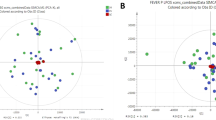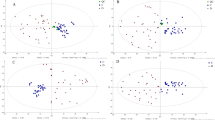Abstract
Purpose
Infections and subsequent septicemia are major complications in neutropenic patients with hematological malignancies. Here, we identify biomarker candidates for the early detection of an infectious origin, and monitoring of febrile neutropenia (FN).
Methods
Proteome, metabolome, and conventional biomarkers from 20 patients with febrile neutropenia without proven infection (FNPI) were compared to 28 patients with proven infection, including 17 patients with bacteremia.
Results
Three peptides (mass to charge ratio 1017.4–1057.3; p-values 0.011–0.024), six proteins (mass to charge ratio 6881–17,215; p-values 0.002–0.004), and six phosphatidylcholines (p-values 0.007–0.037) were identified that differed in FNPI patients compared to patients with infection or bacteremia. Seven of these marker candidates discriminated FNPI from infection at fever onset with higher sensitivity and specificity (ROC-AUC 0.688–0.824) than conventional biomarkers i.e., procalcitonin, C–reactive protein, or interleukin–6 (ROC-AUC 0.535–0.672). In a post hoc analysis, monitoring the time course of four lysophosphatidylcholines, threonine, and tryptophan allowed for discrimination of patients with or without resolution of FN (ROC-AUC 0.648–0.919) with higher accuracy compared to conventional markers (ROC-AUC 0.514–0.871).
Conclusions
Twenty-one promising biomarker candidates for the early detection of an infectious origin or for monitoring the course of FN were found which might overcome known shortcomings of conventional markers.




Similar content being viewed by others
References
von Lilienfeld-Toal M, Dietrich MP, Glasmacher A, Lehmann L, Breig P, Hahn C, et al. Markers of bacteremia in febrile neutropenic patients with hematological malignancies: procalcitonin and IL-6 are more reliable than C-reactive protein. Eur J Clin Microbiol Infect Dis. 2004;23(7):539–44.
Toussaint E, Bahel-Ball E, Vekemans M, Georgala A, Al-Hakak L, Paesmans M, et al. Causes of fever in cancer patients (prospective study over 477 episodes). Support Care Cancer. 2006;14(7):763–9.
Vidal L, Ben Dor I, Paul M, Eliakim-Raz N, Pokroy E, Soares-Weiser K, et al. Oral versus intravenous antibiotic treatment for febrile neutropenia in cancer patients. Cochrane Database Syst Rev. 2013;10:CD003992.
Klastersky J, Paesmans M, Rubenstein EB, Boyer M, Elting L, Feld R, et al. The Multinational Association for Supportive Care in Cancer risk index: a multinational scoring system for identifying low-risk febrile neutropenic cancer patients. J Clin Oncol. 2000;18(16):3038–51.
Sakr Y, Sponholz C, Tuche F, Brunkhorst F, Reinhart K. The role of procalcitonin in febrile neutropenic patients: review of the literature. Infection. 2008;36(5):396–407.
Prat C, Sancho JM, Dominguez J, Xicoy B, Gimenez M, Ferra C, et al. Evaluation of procalcitonin, neopterin, C-reactive protein, IL-6 and IL-8 as a diagnostic marker of infection in patients with febrile neutropenia. Leuk Lymphoma. 2008;49(9):1752–61.
Abrahamsson J, Pahlman M, Mellander L. Interleukin 6, but not tumour necrosis factor-alpha, is a good predictor of severe infection in febrile neutropenic and non-neutropenic children with malignancy. Acta Paediatr. 1997;86(10):1059–64.
Buyukberber N, Buyukberber S, Sevinc A, Camci C. Cytokine concentrations are not predictive of bacteremia in febrile neutropenic patients. Med Oncol. 2009;26(1):55–61.
Uys A, Rapoport BL, Fickl H, Meyer PW, Anderson R. Prediction of outcome in cancer patients with febrile neutropenia: comparison of the Multinational Association of Supportive Care in Cancer risk-index score with procalcitonin, C-reactive protein, serum amyloid A, and interleukins-1beta, -6, -8 and -10. Eur J Cancer Care (Engl). 2007;16(6):475–83.
Fiusa MM, Costa-Lima C, de Souza GR, Vigorito AC, Aranha FJ, Lorand-Metze I, et al. A high angiopoietin-2/angiopoietin-1 ratio is associated with a high risk of septic shock in patients with febrile neutropenia. Crit Care. 2013;17(4):R169.
Peters RP, van Agtmael MA, Danner SA, Savelkoul PH, Vandenbroucke-Grauls CM. New developments in the diagnosis of bloodstream infections. Lancet Infect Dis. 2004;4(12):751–60.
Wong HR. Clinical review: sepsis and septic shock–the potential of gene arrays. Crit Care. 2012;16(1):204.
Siqueira-Batista R, Mendonca EG, Gomes AP, Vitorino RR, Miyadahira R, Alvarez-Perez MC et al. Proteomic updates on sepsis. Rev Assoc Med Bras. 2012;58(3):376–82.
Kiehntopf M, Nin N, Bauer M. Metabolism, metabolome, and metabolomics in intensive care: is it time to move beyond monitoring of glucose and lactate? Am J Respir Crit Care Med. 2013;187(9):906–7.
Kiehntopf M, Schmerler D, Brunkhorst FM, Winkler R, Ludewig K, Osterloh D, et al. SELDI-based protein patterns in the diagnosis of SEPSIS/SIRS. Shock. 2011;36(6):560–9.
Schmerler D, Neugebauer S, Ludewig K, Bremer-Streck S, Brunkhorst FM, Kiehntopf M. Targeted metabolomics for discrimination of systemic inflammatory disorders in critically ill patients. J Lipid Res. 2012;53(7):1369–75.
Freifeld AG, Bow EJ, Sepkowitz KA, Boeckh MJ, Ito JI, Mullen CA, et al. Clinical practice guideline for the use of antimicrobial agents in neutropenic patients with cancer: 2010 update by the Infectious Diseases Society of America. Clin Infect Dis. 2011;52(4):427–31.
Reinhart K, Brunkhorst FM, Bone HG, Bardutzky J, Dempfle CE, Forst H. Prevention, diagnosis, therapy and follow-up care of sepsis: 1st revision of S-2 k guidelines of the German Sepsis Society (Deutsche Sepsis-Gesellschaft e.V. (DSG)) and the German Interdisciplinary Association of Intensive Care and Emergency Medicine (Deutsche Interdisziplinare Vereinigung fur Intensiv- und Notfallmedizin (DIVI)). Ger Med Sci GMS e-J. 2010;8:Doc14.
van den Broek I, Sparidans RW, Schellens JH, Beijnen JH. Specific investigation of sample handling effects on protease activities and absolute serum concentrations of various putative peptidome cancer biomarkers. Clin Proteom. 2010;6(4):115–27.
R_Core_Team. R. A language and environment for statistical computing. Vienna: R Foundation for Statistical Computing; 2012.
Tukey JW. Exploratory data analysis. Reading, Mass. Boston: Addison-Wesley; 1977.
Charlson ME, Pompei P, Ales KL, MacKenzie CR. A new method of classifying prognostic comorbidity in longitudinal studies: development and validation. J Chronic Dis. 1987;40(5):373–83.
Hanley JA, McNeil BJ. A method of comparing the areas under receiver operating characteristic curves derived from the same cases. Radiology. 1983;148(3):839–43.
Gupta A, Singh M, Singh H, Kumar L, Sharma A, Bakhshi S, et al. Infections in acute myeloid leukemia: an analysis of 382 febrile episodes. Med Oncol. 2010;27(4):1037–45.
Gaytan-Martinez J, Mateos-Garcia E, Sanchez-Cortes E, Gonzalez-Llaven J, Casanova-Cardiel LJ, Fuentes-Allen JL. Microbiological findings in febrile neutropenia. Arch Med Res. 2000;31(4):388–92.
Madani TA. Clinical infections and bloodstream isolates associated with fever in patients undergoing chemotherapy for acute myeloid leukemia. Infection. 2000;28(6):367–73.
Chan SM, Chadwick J, Young DL, Holmes E, Gotlib J. Intensive serial biomarker profiling for the prediction of neutropenic Fever in patients with hematologic malignancies undergoing chemotherapy: a pilot study. Hematology reports. 2014;6(2):5466.
Mesters RM, Helterbrand J, Utterback BG, Yan B, Chao YB, Fernandez JA, et al. Prognostic value of protein C concentrations in neutropenic patients at high risk of severe septic complications. Crit Care Med. 2000;28(7):2209–16.
Aimoto M, Koh H, Katayama T, Okamura H, Yoshimura T, Koh S, et al. Diagnostic performance of serum high-sensitivity procalcitonin and serum C-reactive protein tests for detecting bacterial infection in febrile neutropenia. Infection. 2014;42(6):971–9.
Beaufort N, Wojciechowski P, Sommerhoff CP, Szmyd G, Dubin G, Eick S, et al. The human fibrinolytic system is a target for the staphylococcal metalloprotease aureolysin. Biochem J. 2008;410(1):157–65.
Dubin G. Extracellular proteases of Staphylococcus spp. Biol chem. 2002;383(7–8):1075–86.
Ohbayashi T, Irie A, Murakami Y, Nowak M, Potempa J, Nishimura Y, et al. Degradation of fibrinogen and collagen by staphopains, cysteine proteases released from Staphylococcus aureus. Microbiology. 2011;157(Pt 3):786–92.
Simard M, Hill LA, Underhill CM, Keller BO, Villanueva I, Hancock RE, et al. Pseudomonas aeruginosa elastase disrupts the cortisol-binding activity of corticosteroid-binding globulin. Endocrinology. 2014;155(8):2900–8.
Bergamini G, Di Silvestre D, Mauri P, Cigana C, Bragonzi A, De Palma A, et al. MudPIT analysis of released proteins in Pseudomonas aeruginosa laboratory and clinical strains in relation to pro-inflammatory effects. Integr Biol Quant Biosci Nano Macro. 2012;4(3):270–9.
Tilley D, Law R, Warren S, Samis JA, Kumar A. CpaA a novel protease from Acinetobacter baumannii clinical isolates deregulates blood coagulation. FEMS Microbiol Lett. 2014;356(1):53–61.
Bras G, Bochenska O, Rapala-Kozik M, Guevara-Lora I, Faussner A, Kozik A. Extracellular aspartic protease SAP2 of Candida albicans yeast cleaves human kininogens and releases proinflammatory peptides, Met-Lys-bradykinin and des-Arg(9)-Met-Lys-bradykinin. Biol chem. 2012;393(8):829–39.
Langley RJ, Tipper JL, Bruse S, Baron RM, Tsalik EL, Huntley J, et al. Integrative “omic” analysis of experimental bacteremia identifies a metabolic signature that distinguishes human sepsis from systemic inflammatory response syndromes. Am J Respir Crit Care Med. 2014;190(4):445–55.
Langley RJ, Tsalik EL, van Velkinburgh JC, Glickman SW, Rice BJ, Wang C, et al. An integrated clinico-metabolomic model improves prediction of death in sepsis. Sci Transl Med. 2013;5(195):195ra95.
Ray S, Patel SK, Kumar V, Damahe J, Srivastava S. Differential expression of serum/plasma proteins in various infectious diseases: specific or nonspecific signatures. Proteom Clin Appl. 2014;8(1–2):53–72.
Memon RA, Holleran WM, Moser AH, Seki T, Uchida Y, Fuller J, et al. Endotoxin and cytokines increase hepatic sphingolipid biosynthesis and produce lipoproteins enriched in ceramides and sphingomyelin. Arterioscler Thromb Vasc Biol. 1998;18(8):1257–65.
Lanza-Jacoby S, Wong SH, Tabares A, Baer D, Schneider T. Disturbances in the composition of plasma lipoproteins during gram-negative sepsis in the rat. Biochim Biophys Acta. 1992;1124(3):233–40.
Drobnik W, Liebisch G, Audebert FX, Frohlich D, Gluck T, Vogel P, et al. Plasma ceramide and lysophosphatidylcholine inversely correlate with mortality in sepsis patients. J Lipid Res. 2003;44(4):754–61.
Read TE, Harris HW, Grunfeld C, Feingold KR, Kane JP, Rapp JH. The protective effect of serum lipoproteins against bacterial lipopolysaccharide. Eur Heart J. 1993;14(Suppl K):125–9.
Harris HW, Grunfeld C, Feingold KR, Rapp JH. Human very low density lipoproteins and chylomicrons can protect against endotoxin-induced death in mice. J Clin Invest. 1990;86(3):696–702.
Tokumura A. Physiological and pathophysiological roles of lysophosphatidic acids produced by secretory lysophospholipase D in body fluids. Biochim Biophys Acta. 2002;1582(1–3):18–25.
Le LQ, Kabarowski JHS, Weng ZG, Satterthwaite AB, Harvill ET, Jensen ER, et al. Mice lacking the orphan G protein-coupled receptor G2A develop a late-onset autoimmune syndrome. Immunity. 2001;14(5):561–71.
Kao CC, Bandi V, Guntupalli KK, Wu M, Castillo L, Jahoor F. Arginine, citrulline and nitric oxide metabolism in sepsis. Clin Sci (Lond). 2009;117(1):23–30.
Otto GP, Neugebauer S, Claus RA, Sossdorf M. Arginine metabolism is markedly impaired in polymicrobial infected mice. Crit Care. 2012;16(2):412.
Wijnands KA, Castermans TM, Hommen MP, Meesters DM, Poeze M. Arginine and citrulline and the immune response in sepsis. Nutrients. 2015;7(3):1426–63.
Luiking YC, Poeze M, Dejong CH, Ramsay G, Deutz NE. Sepsis: an arginine deficiency state? Crit Care Med. 2004;32(10):2135-45.
McGaha TL, Huang L, Lemos H, Metz R, Mautino M, Prendergast GC, et al. Amino acid catabolism: a pivotal regulator of innate and adaptive immunity. Immunol Rev. 2012;249(1):135–57.
Acknowledgments
We wish to thank Viola Bahr, Cora Richert, Julia Köhler, Kay Stötzer, Sandra Wacker, Andrea Naumann, Heike Simon, and Sandra Pöschmann for technical assistance. This study was supported by the Federal Ministry of Education and Research (BMBF), Germany, FKZ: 01EO1002. The project was further supported by the Paul-Martini-Sepsis Research Group, funded by the Thuringian Ministry of Education, Science and Culture (ProExcellence; grant PE 108-2); the public funded Thuringian Foundation for Technology, Innovation and Research (STIFT), and the German Sepsis Society (GSS).
Author information
Authors and Affiliations
Corresponding author
Ethics declarations
Conflict of interest
The authors declare that they have no conflict of interest.
Additional information
M. E. Richter and S. Neugebauer contributed equally to this manuscript.
Electronic supplementary material
Below is the link to the electronic supplementary material.
Rights and permissions
About this article
Cite this article
Richter, M.E., Neugebauer, S., Engelmann, F. et al. Biomarker candidates for the detection of an infectious etiology of febrile neutropenia. Infection 44, 175–186 (2016). https://doi.org/10.1007/s15010-015-0830-6
Received:
Accepted:
Published:
Issue Date:
DOI: https://doi.org/10.1007/s15010-015-0830-6




